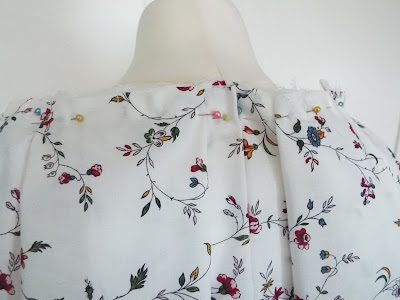I was floored by how wonderful the costumes were, as they had everything from the 1600's-1960's (though unfortunately no 1950's dresses that would help with my college project). My favourite was the Victorian room, as everything in there caught my eye and made an impression, but I also loved the 17th Century and 18th Century displays.
There was an exhibition downstairs centred on Mary Quant, a designer from the swinging sixties, which I also particularly liked as it was bright, featuring quotes and day and evening dresses from the Ginger Group collection. She was one of the designers I researched at one point to see which era of fashion I wanted to explore for the final project.
Playsuit by Mary Quant, black with white stitching - 1968-70.
Two mini dresses, one black and white cotton ticking (1967), and the other acrylic/wool grey check tweed (1967-9). I love these two dresses, and can imagine wearing them with some brightly coloured, bold tights. Maybe mustard or burgundy?
Sac coat, 1967-69. Dogstooth-check rubberised wool.
Then came the Victorian room, which I ADORED. Here we have a day dress from 1863-65 made from tartan glace silk. It's a two-piece dress, trimmed with silk piping and black and white satin bands. I can also see some kind of colourful tassels on the shoulders, though I didn't get a close up photo of it.
Sorry for the bad photo here, I couldn't get one that wouldn't reflect on the glass because of the windows. This is a day dress from 1855-56, made from white muslin, and printed from a roller in purple spots and a floral pattern. The flounces were printed à disposition, meaning that the pattern was printed to fit the flounce.
Now this 1870s dress was my absolute favourite in the whole museum! I love the 1870s and princess line dresses, as well as the duck egg colour of this gown, so it was just my cup of tea! It's an afternoon dress from 1878-80; the description says that it's a trained princess-line dress made from pale green wool/silk mixed fabric, trimmed with blue satin and silk embroidery.
Isn't the embroidery and shape divine?
Even the train is embroidered.
Afternoon dress, 1883-85. It's a two piece gown fashioned from green/grey silk satin with a boned bodice and trimmed with beige lace.
Detail of the bodice. I really like how the colour goes with the lace.
Day dress from 1894-96, in two pieces with a very pale green flecked and corded silk, trimmed with a darker green velvet. I couldn't get a good photo that had all of the gown included, but it is just plain/the same fabric as the rest of the skirt all the way to the hem, without any trimmings at the bottom.
Corset, crinoline, chemise, drawers, and cap. 1860-70. The red is very fetching!
I just love this demi-bust corset, the colour is fabulous and it has cute diamond-shaped stitching patterns! Looks like I've found a new dream corset.
A man's doublet. 1625-35.
I think the fabric is all hand-done French knots from what I can remember, though I may be wrong!
A gorgeous pair of stays with a stomacher, 1620-40.
A pale pink woman's bodice embellished with black beading. 1650-60.
The feathered details, which were apparently uncommon for clothing at this period, but featured heavily in home textiles such as curtains and rug designs. I think it looks beautiful and delicate with the pink.
I didn't take a photo of the date or description of this one for some reason, but I wanted to include it because I really liked the shape and embroidery of it!
Is this called blackwork embroidery? It has tiny little sequins/spangles too.
Two candy-coloured men's waistcoats from 1780-1800. Love the salmon pink and pale blue!
This was my second-favourite dress in the whole museum, and one that received a lot of positive attention on the 18th Century Sewing group on Facebook when I posted it. It's so delicate and sweet in a shade of powder blue. Sackback dress, 1766. Striped blue and white figured silk. Trimmed with silk fringing, silk flounces, ruched bands, and double-tier silk sleeve ruffles.
I had to get many photos of this for all the details and because I adored it.
Chintz dress, 1775-80. Open robe of glazed cotton, printed with rows of stylised sprigs in India and then printed again in England with alternating bands of floral wavy lines.
Skirt looped up à la polonaise style.
I don't think I got a description of this one, but I'm guessing that it's a round gown from the early 1790s with a vandyked flounce at the neck, drawn together by ribbon through a channel. Sorry if I'm wrong, please correct me.
Evening dress, 1798-1800. White cotton muslin open robe, embroidered with tiny metal stars all over, which the sign remarks would have been very costly at the time to make.
Open robe of brown silk satin, 1793-96. It's printed with a warp print (chine) motif in stripes of white and green.
All together! It was crowded, so you might see why it was hard to get good photos, and I was also pushed for time. Which gown is your favourite? Comment below!

















































